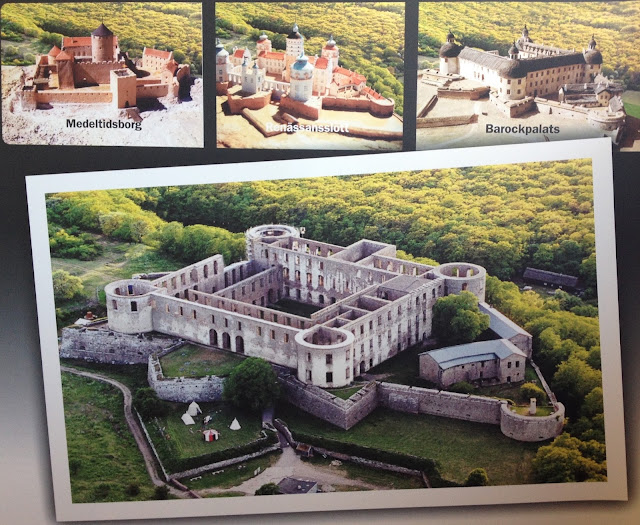Gull Spots a Babe
Vacation season is on, so we worried about finding lodging on Oland Island, a popular vacation site in Southern Sweden. From Wikipedia:
Öland (help·info) is the second largest Swedish island[note] and the smallest of the traditional provinces of Sweden. Öland has an area of 1,342 km² and is located in the Baltic Sea just off the coast of Småland. The island has 25,000 inhabitants.[1] It is separated from the mainland by the Kalmar Strait and connected to it by the 6-km Öland Bridge, which opened on 30 September in 1972. If written in other languages than Swedish it could also be spelled as Oland or Øland (the latter in other Scandinavian languages).
John and Stuart struck up a conversation with our hotel bartender, who's sister worked at a guest house in Borgholm, about 20 miles north of the ferry terminal. Bicycles are prohibited on the bridge, so a ferry service takes bikes and walk-ons. Normal adult fare=50 SK; geezer fare (Termed pensioner)=35 SK. Fortunately, the ferry was packed, offering Dan time to arrive with seconds to spare.
But first, about Kalmar's significance:
The Kalmar Union or Union of Kalmar (Danish, Norwegian and Swedish: Kalmarunionen; Latin: Unio Calmariensis) was a state that brought together the Scandinavian nations from 1397 to 1523.[1]
It was a personal union that joined under a single monarch the three kingdoms of Denmark, Sweden (then including Finland), and Norway, together with Norway's overseas dependencies (then including Iceland, Greenland, the Faroe Islands and the Northern Isles). The Union was not quite continuous; there were several short interruptions. Legally the countries remained separate sovereign states, but with their domestic and foreign policies being directed by a common monarch.
One main impetus for its formation was to block German expansion northward into the Baltic region. The main reason for its failure to survive was the perpetual struggle between the monarch, who wanted a strong unified state, and the Swedish and Danish nobility which did not.[2] Diverging interests (especially the Swedish nobility's dissatisfaction with the dominant role played by Denmark and Holstein) gave rise to a conflict that would hamper the union in several intervals from the 1430s until its definitive breakup in 1523 when Gustav Vasa became king of Sweden.[3]
1667 Building
Our Hotel in Kalmar
Kalmar Cathedral
Kalmer Castle Model
Kalmar Castle #1
Kalmar Castle #2
Kalmar Castle #3
Huge Weeping Birch
Dedicated to Our Wives
Last Unicorn in Sweden
Purple Flowers in Front of the Cathedral
Kalmar Harbor
Aging Thached Roof. Both Sweden and Denmark thatch roofers place rough-cut timbers at the crown of the roof. UK thatchers tend to add another row or layer of thatch, and might carve shapes in the thatch. Specific UK thatchers might mount a signature animal, such as a pheasant, on the ridge line, sculpted out of thatch, as a branding symbol.
Cold Storage. These low-slung buildings are set in the ground and used to store produce.
Old and New Technology. The cows appear unimpressed.
Characteristic Oland Island Windmills. Note the Midsummer Eve May pole on the left. On Midsummer's Eve, Swedes decorate or wrap the pole with flowers, now turned brown.
Typical Road with John, Dan, and Stuart. We generally followed designated cycle routes, but the signage could be better.
Dedicated to Nancy Pulver Rxxxn
Grandfather and Granddaughter Sharing a Moment
Explains the next two photos
Borgholm Stott (Castle) Model
Borgholm Stott. Note the three eras, medieval, renaissance, and baroque.
Borgholm Stott. The model is in much better condition.
Another Windmill and May Pole
Dog of the Day
Blogging at Villa Ingrid, Borgholm, Oland Island, Sweden. Sweden regulates beer. For those who need to know, the explanation is posted below the next photo. That's a Class II Carlsberg on the table, made in Denmark. Villa Ingrid is proving to be an excellent find.
Villa Ingrid, Borgholm, Oland Island, Sweden.
Sweden[edit]
Only classes I and II can be purchased in supermarkets, while class III can only be purchased in restaurants licensed to do so, and the state shops Systembolaget. Class II beer is loosely divided into two sub-groups, light "Folköl" ("People's Beer") with a maximum ABV of 2.8% and normal "Folköl", with a maximum ABV of 3.5%. An alcohol content of 2.8% and below is not subject to specific, higher, alcohol taxes, but only to VAT (12%) as any other food or non-alcoholic drink. Class III beer is also, unofficially, divided into two sub-groups, "Mellanöl" ("in-between beer"), with ABV between 3.6% and 4.5%, and normal "strong beer" with ABV above 4.5%. . . . Before 1997, alcohol by weight was used, and then the limit for shops was 2.8 %, same as 3.5 % alcohol by volume, which was a source of confusion.
| alcohol content (ABV) | available in restaurants | available in supermarkets | taxed | |
|---|---|---|---|---|
| Class I (Lättöl) | 0.0% - 2.25% | yes | yes | no |
| Class II (Lätt Folköl) | 2.8% | yes | yes | no |
| Class II (Folköl) | 3.5% | yes | yes | yes |
| Class III (Mellanöl) | 3.6% - 4.5% | yes | no | yes |
| Class III (Starköl) | 4.6% + | yes | no | yes |
Train Travel with Bikes in Sweden. While the Swedes have nearly everything thoughtfully organized, the have real issues with trains. Why would a country with so much infrastructure devoted to quality bike paths, lanes, and bike-friendly traffic laws permit their train operators to refuse to carry bicycles? Nearly everyone of all ages in Sweden bikes, yet bikes are not permitted on the two major train systems under this environmental heading:
SJ.se - Travel By Train - A Good Environmental Choice ...
Bikes
Due to space reasons you are not allowed to bring your bike on the train. However, if the bike is foldable and you can carry it yourself as hand luggage, you may take it with you.



































No comments:
Post a Comment